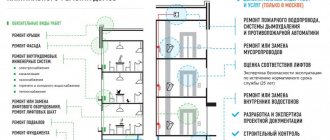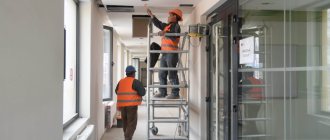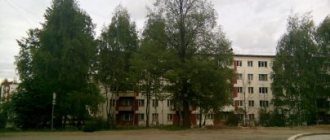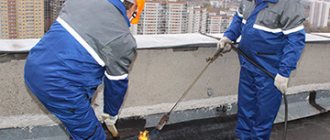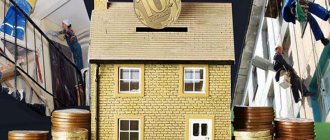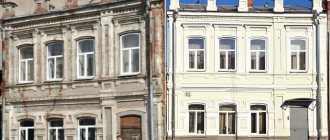Every year, based on data provided by the management company, homeowners association or homeowners in apartment buildings (MCD), the government authority of a constituent entity of the Russian Federation develops and updates a regional capital repair program. This document contains a list of houses in which repair work needs to be carried out, as well as the start date for their implementation .
Depending on the individual characteristics of the apartment building, its place in the queue for major repairs is determined. The regional program does not include houses in disrepair, as well as buildings with a high percentage of wear and tear.
Residents are notified about major repairs 6 months before the start of work . You can view the year of major repairs in your home via the Internet on the website of the regional operator or the Housing and Communal Services Reform portal.
Short-term plan for capital repairs of apartment buildings
The date for major repairs for each specific house is set by the regional program. The regional authorities are developing programs for up to 30 years . In order to specify the period for carrying out repair work, as well as to calculate the types and volumes of financing, the administrative apparatus of the subject develops short-term plans for the implementation of the regional program for a period of no more than 3 years (clause 7 of Article 168 of the Housing Code of the Russian Federation).
Short term plans contain:
- list of apartment buildings included in the regional program;
- the cost of work and services for each specific type of repair;
- start dates for work.
The developed program and plans for its implementation are updated annually . Based on the changes that have occurred, it is determined:
- what amount of work remains to be done in the future;
- how much funds need to be allocated;
- in which apartment buildings it is necessary to suspend or completely interrupt major repairs.
What objects are included in the program?
The main document regulating the procedure and sequence of major repairs of apartment buildings is the Housing Code of the Russian Federation.
According to the Housing Code, regional programs for the overhaul of common property in apartment buildings must include all apartment buildings located on the territory of the Russian Federation , with the exception of those that are in disrepair and are subject to demolition. The list of organizations that have the right to carry out work on the overhaul of apartment buildings is determined by the Town Planning Code of the Russian Federation.
Major repairs, current and reconstruction are concepts that many mistakenly interpret as synonyms. What is their difference, as well as what are the standards for carrying out major repairs of the facade, roof and roof - read in separate articles.
How the queue for major repairs of apartment buildings is formed
in drawing up a plan for the overhaul of apartment buildings. The need for major repairs is determined based on building codes and operational characteristics of parts of the building. The order is influenced by:
- date of construction of the apartment building and the year in which major repairs were last carried out;
- the amount of work required;
- degree of deterioration of the building;
- a sufficient amount of money collected (repair work can be carried out faster if the contribution amount is increased);
- degree of activity of residents;
- square area.
First of all, the regional program includes houses that required major repairs at the time of privatization of the first residential premises, provided that such work had not been carried out at the date of approval of the program.
The queue for major repairs does not include :
- subject to demolition or reconstruction .
- Houses with less than 3 apartments .
- MKD, the physical wear of structural elements of which is more than 70% .
- Buildings in which the cost of work per 1 m2 of total area exceeds the minimum contribution established in the region.
Major repairs can be carried out in one house at different times. For example, roof replacement may be scheduled for 2021, and elevator equipment replacement may be scheduled for 2023.
Update schedule
Any construction work is paid for from replenished funds from the Capital Repair Fund, so restoration cannot be carried out in all buildings at once. In this regard, priority lists are drawn up. They indicate the approximate date of major renovation of the house at the address.
Note! Repair work is not carried out every year. They can be extended over several years. For example, in 2019 it is planned to improve the condition of risers and cold water distribution lines. And the replacement of the elevator is only scheduled for 2033.
The schedule for major repairs of apartment buildings is drawn up based on their current condition, as well as the standards for repairing and replacing equipment. New buildings are not included in the lists, although funds in its favor are collected from citizens. This is due to the fact that according to the standards, the first serious repair and construction work to improve the condition of the building is carried out after 40-50 years.
How to find out in what year there will be a major home renovation
The list of apartment buildings that require major repairs is compiled by local authorities based on information received from management organizations about the technical condition of buildings. The timing of the work is calculated for each specific house individually.
The approximate time frame after which repair work must be carried out is not established . You need to focus on the service life of individual elements of the building, as well as the last date for major repairs.
in advance about major repairs . The organization of repair work and the notification procedure are established by the regulatory act of the constituent entity of the Russian Federation.
Typically, a message about major repairs the apartment building accessible to all residents For example, on a notice board at the entrance. Citizens must be warned about the start of repair work at least six months in (clause 3 of article 189 of the Housing Code of the Russian Federation).
Depending on the method of forming the capital repair fund, the obligation to notify is assigned to:
- Regional operator.
- An initiative group of residents managing apartment buildings.
Homeowners who have chosen the method of forming a capital repair fund on an individual bank account independently determine the need for repair work in their apartment building, and also have the right to pay from the fund for additional capital repair services:
- development of project documentation;
- payment for construction control;
- repayment of loans and borrowings spent on repairs.
Find out when major repairs will take place at the address (online)
You can find out the schedule for major repairs through the Internet resource Housing and Communal Services Reform . The website contains information about all existing regional programs on the territory of a constituent entity of the Russian Federation. At the moment, information about more than 700 thousand objects .
To view the information you need to:
- Go to the site using the link.
- In the “Find your home” , enter the address of the apartment building (city, street, house number).
- A page with a house card will open, which contains all the information about the object - date of construction, square area, name of the service organization, amount of accumulated funds, total outstanding payments, etc.
- In the “Major Repairs” you can find out what work has been carried out and what is planned; “Passport” tab contains all the technical characteristics of the MKD.
Information about what major repairs are planned for the near future can be found on the local administration website . The text of the regional program with the list of MKD included in it can be found in the “Documents” section.
Where to see the timing of major renovations of an apartment building
During the overhaul process, work is carried out on:
- restoration of walls, facade and foundation;
- repair and replacement of elevator equipment;
- replacement of engineering and technical communications;
- roof and basement repairs.
Repair work to restore or replace certain elements of a building is a fairly complex activity. The deadlines are set for each specific type of repair by the owners in agreement with the contractor (clause 3, clause 5, article 189 of the RF Housing Code) and are fixed in the work contract .
Depending on the amount of funding and the complexity of the work being carried out, the start and end dates of the overhaul may vary .
The deadlines set must be reasonable and not cause inconvenience to homeowners.
Current and major repairs. What does a contractor need to know? Part I
03/09/2019
As is known, part 1 of Article 55.8 of the Town Planning Code of the Russian Federation (hereinafter referred to as the Civil Code of the Russian Federation) directly stipulates that an individual entrepreneur or legal entity has the right to carry out construction, reconstruction, major repairs, demolition of capital construction projects under a construction contract, under a contract for the implementation of demolition agreement concluded with the developer, technical customer, person responsible for the operation of the building, structure, or regional operator, provided that such an individual entrepreneur or such legal entity is a member of a self-regulatory organization in the field of construction, reconstruction, major repairs, demolition of capital construction projects .
It follows from this norm that membership in a construction SRO is necessary only for subjects of law who, in particular, carry out capital, and not current, repairs of a capital construction project.
The legal department of the Association of SROs "Commonwealth of Builders" quite often receives requests with the question: how to distinguish a major repair from a current one?
Clause 14.2 of Article 1 of the Civil Code of the Russian Federation establishes that major repairs of capital construction projects (except for linear objects) - replacement and (or) restoration of building structures of capital construction projects or elements of such structures, with the exception of load-bearing building structures, replacement and (or) restoration of systems engineering and technical support and networks of engineering and technical support for capital construction projects or their elements, as well as the replacement of individual elements of load-bearing building structures with similar or other elements that improve the performance of such structures and (or) restoration of these elements. As indicated by the “Methodological recommendations for organizing prosecutorial supervision over the implementation of legislation during the resettlement of citizens from emergency housing stock and major repairs of common property in apartment buildings” (approved by the Prosecutor General’s Office of Russia on January 21, 2019 No. 71-16-2019), the characteristic features of major and current repairs are defined in paragraph 14.2 of Article 1, Article 55.24 of the Civil Code of the Russian Federation.
The main distinguishing feature of a major overhaul from a current one is the purpose of its implementation. If current repairs are intended to maintain the parameters of stability and reliability of buildings, then major repairs are aimed at restoring, replacing worn-out structures (including load-bearing ones) or changing the parameters of the building.
In addition, to carry out major repairs, the design documentation provided for in Part 2 of Article 48 of the Civil Code of the Russian Federation is required. When carrying out routine repairs, such documentation is not prepared. By letter dated 07/03/2017 No. 29521-OG/04 “On the issue of distinguishing the concepts of “major repairs” and “current repairs”, the Ministry of Construction of Russia considers it appropriate to be guided by part 14.2 of article 1 of the Civil Code of the Russian Federation and paragraph 2.2 of the Methodological Manual on the content when distinguishing between the concepts of capital and current repairs and repair of the housing stock MDK 2-04.2004, according to which current repairs of the common property of a residential building are repairs carried out in a planned manner in order to restore the serviceability or operability of a residential building, partially restore its resource with the replacement or restoration of its components of a limited range established by regulatory and technical documentation.
A more recent legal position of the Ministry of Construction of Russia (letter dated February 27, 2018 No. 7026-AS/08) is that current repairs include the elimination of minor faults identified during the daily operation of a fixed asset, in which the object is practically not out of service, and its technical characteristics do not change, work on systematic and timely protection of fixed assets from premature wear by carrying out preventive measures; capital repairs include the restoration of the lost original technical characteristics of the object as a whole, while the main technical and economic indicators remain unchanged.
In addition to the above, we consider adding the opinion of the legal department of the Association of SROs “Commonwealth of Builders”, which is that the difference between current repairs and major repairs lies in the type and nature of the work performed. As an example, let us turn to regulations adopted quite a long time ago, but currently in force, which provide a fairly clear distinction between these concepts, for example, to the Decree of the USSR State Construction Committee of December 29, 1973 No. 279 “On approval of the Regulations on carrying out planned preventive maintenance” repair of industrial buildings and structures" (MDS 13-14.2000), Appendix 8 of which establishes a list of work on major repairs of buildings and structures, dividing them according to these criteria.
To save the reader’s time searching for the specified legal acts, we will quote the named works on the basis of “building”, as most often mentioned in questions from builders: I. Foundations
1. Changing wooden chairs or replacing them with stone or concrete pillars.
2. Partial relocation (up to 10%), as well as strengthening of stone foundations and basement walls, not associated with the superstructure of the building or additional loads from newly installed equipment. 3. Restoration of vertical and horizontal insulation of foundations. 4. Restoration of the existing blind area around the building (more than 20% of the total area of the blind area). 5. Repair of existing drains around the building. 6. Replacement of single collapsing stone and concrete pillars. II.
Walls and columns 1. Seal cracks in brick or stone walls, clearing grooves, and bandaging seams with old masonry.
2. Construction and repair of structures that strengthen stone walls. 3. Relaying of dilapidated brick cornices, lintels of pit parapets and protruding parts of walls. 4. Relaying and repair of individual dilapidated sections of stone walls up to 20% of the total volume of masonry, not associated with the superstructure of the building or additional loads from newly installed equipment. 5. Strengthening reinforced concrete and stone columns with clips. 6. Repair and partial replacement (up to 20% of the total volume) of columns, not associated with additional loads from newly installed equipment. 7. Change of fillers in walls with stone, reinforced concrete and metal frames (up to 40%). 8. Replacement of dilapidated crowns of log or cobblestone walls (up to 20% of the total surface of the walls). 9. Continuous caulking of log or cobblestone walls. 10. Partial replacement of sheathing, backfill and slab insulation of frame walls (up to 50% of the total wall area). 11. Replacement or repair of cladding and insulation of wooden plinths. 12. Repair of stone plinths of wooden walls with their relocation up to 50% of the total volume. 13. Re-installation and replacement of worn-out clamps of log and cobblestone walls. III.
Partitions 1. Repair, change and replacement of worn partitions with more advanced designs of all types of partitions.
2. When carrying out major repairs of partitions, partial redevelopment is allowed with an increase in the total area of the partitions by no more than 20%. IV.
Roofs and coverings 1. Replacement of dilapidated wooden covering trusses or replacing them with prefabricated reinforced concrete ones.
2. Complete or partial replacement of dilapidated metal and reinforced concrete trusses, as well as replacement of metal trusses with prefabricated reinforced concrete trusses. 3. Strengthening trusses when changing types of covering (replacing wood slabs with precast reinforced concrete, cold coverings with warm ones, etc.), when suspending lifting devices, as well as in case of corrosion of components and other elements of metal and prefabricated reinforced concrete trusses. 4. Partial or complete replacement of rafters, mauerlats and sheathing. 5. Repair of load-bearing structures of skylights. 6. Repair of devices for opening the covers of skylights. 7. Partial or complete replacement of dilapidated coating elements, as well as their replacement with more progressive and durable ones. 8. Partial (over 10% of the total roof area) or complete replacement or replacement of all types of roofing. 9. Reconstruction of roofs due to replacement of roofing material. 10. Partial or complete replacement of wall gutters, slopes and coverings of chimneys and other protruding devices above the roof. V. Interfloor ceilings and floors
1. Repair or replacement of interfloor ceilings.
2. Replacement of individual structures or floors as a whole with more advanced and durable structures. 3. Strengthening all types of interfloor and attic floors. 4. Partial (more than 10% of the total floor area in the building) or complete replacement of all types of floors and their bases. 5. Reconstruction of floors during repairs with replacement with stronger and more durable materials. In this case, the type of floors must comply with the requirements of the standards and technical conditions for new construction. VI.
Windows, doors and gates 1. Complete replacement of dilapidated window and door units, as well as gates of production buildings.
VII.
Stairs and porches 1. Partial or complete replacement of staircases, ramps and porches.
2. Change and strengthening of all types of stairs and their individual elements. VIII.
Internal plastering, tiling and painting works 1. Resumption of plastering of all premises and repair of plaster in an amount of more than 10% of the total plastered surface.
2. Change of wall cladding in an amount of more than 10% of the total area of veneered surfaces. 3. Continuous anti-corrosion painting of metal structures. IX.
Facades 1. Repair and renewal of cladding of an area of more than 10% of the lined surface.
2. Complete or partial (more than 10%) restoration of plaster. 3. Complete restoration of rods, cornices, belts, sandriks, etc. 4. Renewal of molded parts. 5. Continuous painting with stable compounds. 6. Cleaning the facade with sandblasting machines. 7. Change of balcony slabs and fences. 8. Change of coverings of protruding parts of the building. X. Furnaces
1. Complete refurbishment of all types of heating furnaces, chimneys and their bases.
2. Re-equipment of furnaces to burn coal and gas. 3. Complete refurbishment of kitchen stoves. XI.
Central heating 1. Replacement of individual sections and units of heating boilers, boiler units, or complete replacement of boiler units (if the boiler unit is not an independent inventory item).
2. Repair and replacement of expanders, condensation traps and other network equipment. 3. Repair and re-laying of foundations for boilers. 4. Automation of boiler rooms. 5. Transfer from stove heating to central heating. 6. Changing heating registers. 7. Connection of buildings to heating networks (at a distance from the building to the network of no more than 100 m). XII.
Ventilation 1. Partial or complete replacement of air ducts.
2. Changing fans. 3. Rewinding or changing electric motors. 4. Change of dampers, deflectors, throttle valves, blinds. 5. Partial or complete replacement of ventilation ducts. 6. Change of air heaters. 7. Change of heating units. 8. Changing filters. 9. Change of cyclones. 10. Change of individual chamber designs. XIII.
Water supply and sewerage 1. Partial or complete replacement of the pipeline inside the building, including water supply inlets and sewerage outlets.
XIV.
Hot water supply 1. Change of coils and boilers.
2. Change of pipeline, parts and, in general, pumping units, tanks and pipeline insulation. XV.
Electrical lighting and communications 1. Replacement of worn-out sections of the network (more than 10%). 2. Change of safety shields. 3. Repair or restoration of cable channels. 4. When overhauling the network, it is allowed to replace lamps with other types (conventional ones with fluorescent ones).
You can find the list of works for the second sign of “structure” by referring directly to the text of the document.
In the next part of the series of articles, it is planned to talk about the lists of main works carried out during major repairs for social and cultural facilities and residential premises.
And according to established tradition, at the end of each article we remind you that the specialists of the legal department of the Association of SROs “Commonwealth of Builders” are always ready to provide free advice on legal issues that arise not only in the construction sector, but also in other areas. Let us repeat that we are interested in this, first of all, solely for the purpose of professional self-improvement and accumulation of experience, for you - perhaps the legal solution we have found will be the most optimal in solving your problem.
Our website on the Internet: www.sodstr.ru.
Request information on the Moscow Mayor's portal
A more detailed report can be obtained on the website of the Moscow Mayor - mos.ru. However, only registered users can do this. Registration in the ESIA system is suitable.
On the site you need to go sequentially through the branches:
- «;
- “Housing, housing and communal services, yard”;
- "Apartment building and courtyard";
- “Get information from the Capital Repair Fund.”
The request is free, information is provided online. The user receives information about the expected date of restoration of the building. And also about the amount of savings to pay for repair and construction work. And if the work is already being carried out or has been carried out recently, the citizen receives a report indicating the contractors.
Lists for the coming years
The main source of knowledge for residents of high-rise buildings should be the portal of the Moscow Apartment Buildings Overhaul Fund at fond.mos.ru. On the main page of the resource, there is a side menu on the left, where you should select the “Short-term capital repair plan” item.
This section contains a list of constantly updated documents with a schedule for major renovations of houses in Moscow until 2021. The user needs to select a document at the top of the list with the specification “Current edition”. The list itself will open on a new page, divided into several parts.
All documents are opened in PDF format and are presented in a table containing:
- exact address (including county and municipality);
- year of construction;
- square;
- year the overhaul began;
- list of events to be held;
- where the payment is transferred from.
Reference! The list is constantly updated due to the completion of repair work. Most buildings need to fix almost all communications at once, so the overhaul program is progressing rather slowly.
Program schedule until 2044
You can view the schedule for major renovations of a house at an address in Moscow not only for the coming years. A regional program for the overhaul of common property in Moscow apartment buildings until 2044 has already been developed. The information is freely available on the website repair.mos.ru.
